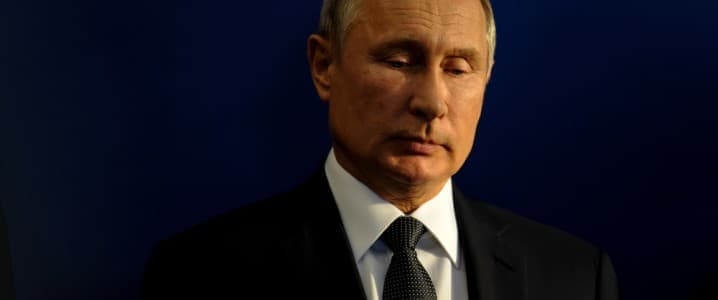Some of the numbers coming out of Moscow this quarter are setting off alarms in various corridors. There is some fundamental basis to this theory, but it’s also very ‘Western’ driven.
The Western theory is that we’re now seeing what happens when a military budget expands faster than the fiscal engine powering it. For the first time since the full-scale invasion began, Russia’s oil and gas revenues are not just underperforming, they’re actively undermining the Kremlin’s war strategy. Year-to-date, budgeted hydrocarbon receipts are down more than 20%. That’s a 5.4 trillion-ruble hole that Moscow’s finance ministry is struggling to patch in real time. The original 2025 budget assumed a lifeline of 10.94 trillion rubles in energy taxes. That’s now been revised downward to 8.32 trillion. Quietly, they’ve also tripled the expected deficit from 0.5% to 1.7% of GDP.
That shortfall is believed to be colliding directly with a ballooning military-industrial complex that now eats up somewhere between 32% and 40% of total federal spending, depending on how you classify “security.” Civilian ministries are being bled out to keep factories in Tatarstan running at wartime tempo.
British intelligence and multiple EU partners are now operating under the assumption that Russia has entered what one official called a “forward mortgaged economy”, where future oil and gas income is already spoken for, but the barrels aren’t selling fast enough…
Some of the numbers coming out of Moscow this quarter are setting off alarms in various corridors. There is some fundamental basis to this theory, but it’s also very ‘Western’ driven.
The Western theory is that we’re now seeing what happens when a military budget expands faster than the fiscal engine powering it. For the first time since the full-scale invasion began, Russia’s oil and gas revenues are not just underperforming, they’re actively undermining the Kremlin’s war strategy. Year-to-date, budgeted hydrocarbon receipts are down more than 20%. That’s a 5.4 trillion-ruble hole that Moscow’s finance ministry is struggling to patch in real time. The original 2025 budget assumed a lifeline of 10.94 trillion rubles in energy taxes. That’s now been revised downward to 8.32 trillion. Quietly, they’ve also tripled the expected deficit from 0.5% to 1.7% of GDP.
That shortfall is believed to be colliding directly with a ballooning military-industrial complex that now eats up somewhere between 32% and 40% of total federal spending, depending on how you classify “security.” Civilian ministries are being bled out to keep factories in Tatarstan running at wartime tempo.
British intelligence and multiple EU partners are now operating under the assumption that Russia has entered what one official called a “forward mortgaged economy”, where future oil and gas income is already spoken for, but the barrels aren’t selling fast enough to keep up. Deep discounts to China and India were meant to cushion the blow from the West, but that model is fraying. With the ruble unexpectedly strong this year (up 45%), every dollar of oil revenue buys fewer rubles. That sounds like stability on the surface, but underneath, it’s eroding the tax base Moscow counts on.
Add to that the EU and UK’s latest oil cap revision ($47.60 a barrel for Urals-grade, enforced through shipping and insurance restrictions), and you’re now watching the Kremlin try to balance its wartime ambitions on margins that barely exist.
And the battlefield continues to absorb resources at an unsustainable clip. Nightly Russian drone waves over Ukraine are hitting 600 to 700 units. These are often Geran-2 variants, redesigned with components that aren’t supposed to be getting through the sanctions net. Western defense officials suspect Chinese circuitry is still reaching assembly plants through shell importers. Whatever the source, Russia’s made drone warfare a priority doctrine, reportedly carving out an entirely new service branch just for UAV operations.
Inside the Kremlin, there’s no appetite for rollback. Putin’s administration is still projecting full-spectrum defense spending through 2027, even if the National Wealth Fund (once upon a time, Russia’s rainy-day war chest) is being drained month by month. Several independent economists now warn that at this burn rate, reserves could run dry in 12 to 14 months unless oil rebounds or sanctions falter. Neither is likely.
The Central Bank has tried to stay out of the political crossfire, but it’s not blind. In its internal assessments, inflation expectations are rising, capital flight is again ticking upward, and consumer lending is being propped up by artificial subsidy. They’re back to Soviet-style financial repression, dressed up in digital rubles and patriotic bonds.
This is what a command economy looks like when the command loses its voice. The gears are still turning, but they’re grinding faster than they were built for.
Unless there’s a systemic external shock, it looks like there could be a fiscal reckoning in Moscow. And while you might not see that on Russian TV, it’s the baseline in most Western and regional intelligence estimates.
But is it just Western wishful thinking? It’s important to keep in mind that Russia has deep experience operating under sanctions and oil shocks. The Kremlin has already shown a willingness to delay social spending, draw on the National Wealth Fund, and tighten capital controls to stay solvent. In other words, it can grind through fiscal pain longer than most Western governments.
Chinese analysts see Russia’s energy sector as weakened but adaptive, with strategic pivots to Asia and a growing reliance on the yuan. They’re not forecasting a collapse. Instead, they’re forecasting constrained power projection.
The idea that the National Wealth Fund will be “depleted in a year” assumes no further oil recovery, no spending rebalancing, and no fiscal tightening. That’s a worst-case Western scenario, and not necessarily a baseline. Moscow has already slowed disbursements and is preparing new taxation tools, including increased mineral extraction taxes and possible capital gains levies on state-linked firms.
Western forecasts of collapse are often driven by hopeful signaling. But the reality is more ambiguous. Russia is under acute financial strain, but it is not in freefall.
